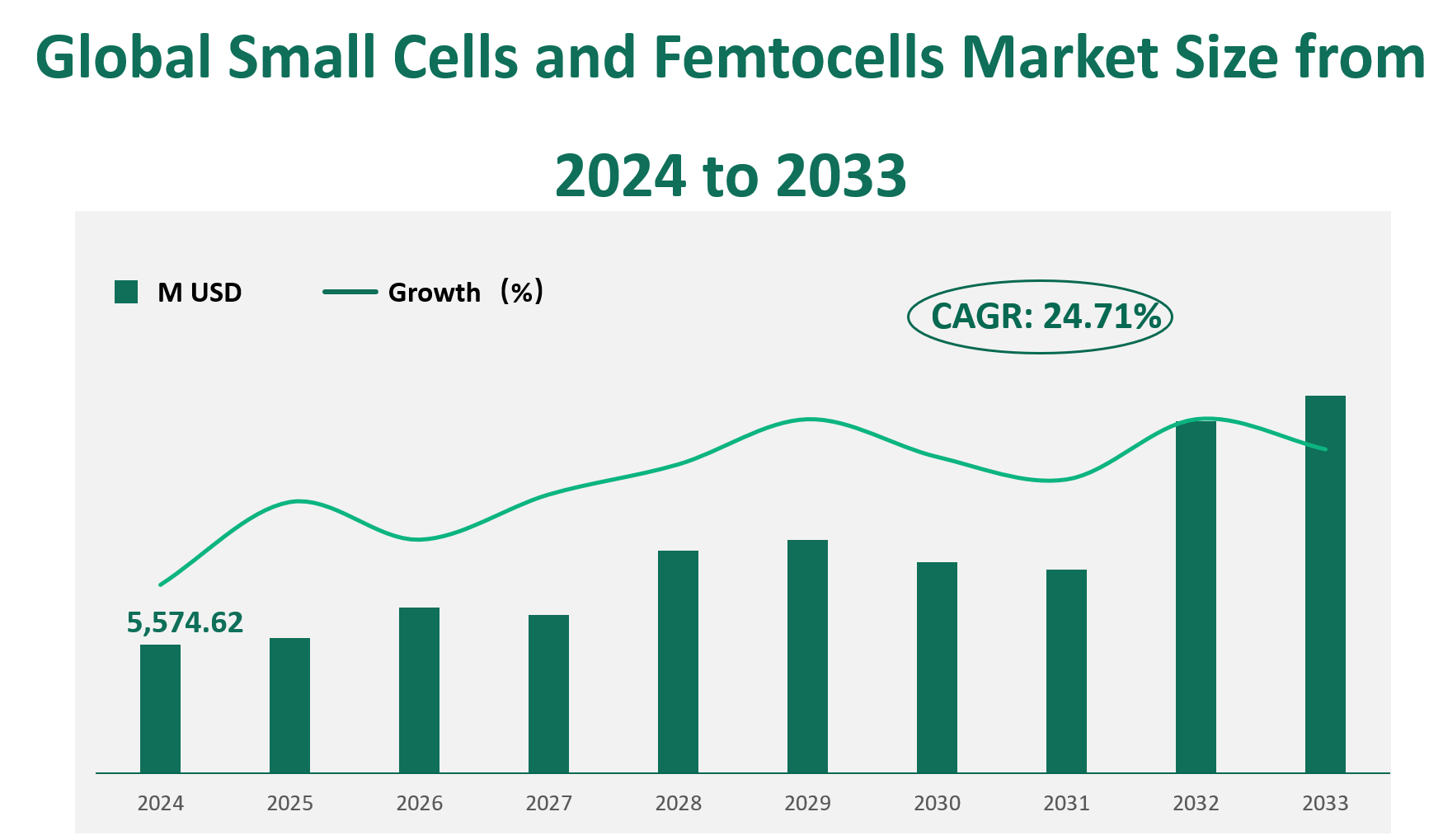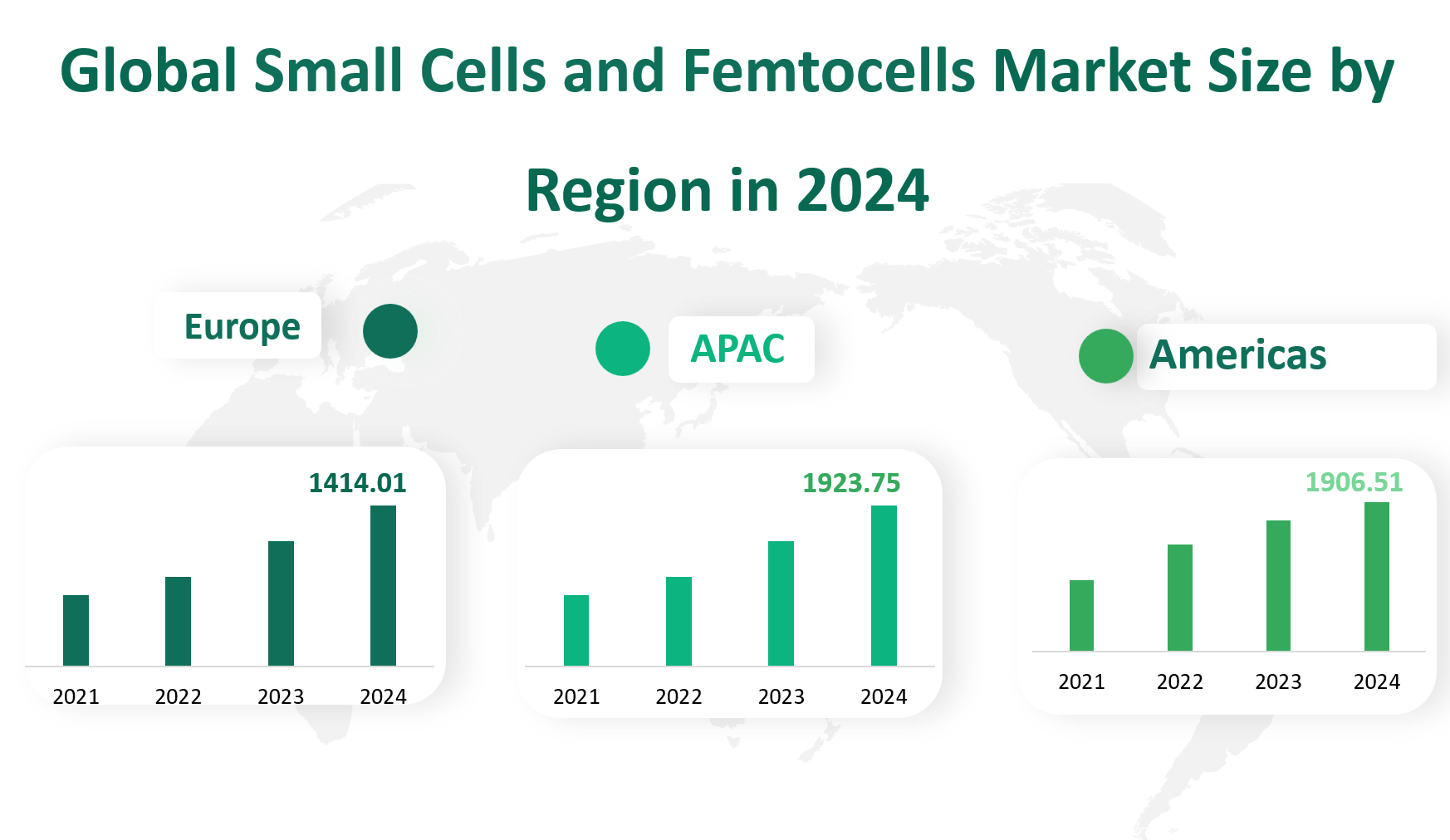1. Global Small Cells and Femtocells Market Insight Analysis
In 2024, the global Small Cells and Femtocells market value is projected to reach 5,574.62 million USD, with a robust compound annual growth rate (CAGR) of 24.71% over the next few years.
Small Cells and Femtocells are integral components of modern wireless communication networks. Small Cells are low-powered radio access nodes designed to enhance network coverage and capacity in densely populated urban areas or indoor environments. They are typically used to offload traffic from macrocells and improve user experience by providing localized, high-speed connectivity. Femtocells, on the other hand, are smaller, residential or enterprise-based solutions that connect to a user’s broadband network to provide improved cellular coverage within a limited area, such as homes or small offices. These devices are particularly useful in areas with poor macrocell coverage, ensuring seamless connectivity and higher data rates.
The market’s growth is further propelled by the increasing adoption of mobile devices, the need for heterogeneous networks, and the significant improvements in 5G infrastructure. As the demand for high-speed, low-latency connectivity continues to rise, Small Cells and Femtocells are becoming essential tools for network operators to meet these requirements efficiently and cost-effectively.
Figure Global Small Cells and Femtocells Market Size (M USD) and CAGR (2024-2033)

2. Driving and Limiting Factors of Small Cells and Femtocells Market Growth
The growth of the Small Cells and Femtocells market is driven by several key factors. Firstly, the increasing number of mobile Internet users has put immense pressure on existing network infrastructures. Traditional base stations are often unable to handle the surge in data traffic, making Small Cells and Femtocells attractive solutions due to their ability to provide localized, high-capacity coverage. Secondly, the shift towards digitalization has led to a significant increase in enterprises’ demand for wireless networks. These solutions offer enhanced connectivity, supporting high-speed data rates and ultra-reliable low-latency communications, which are crucial for modern business operations.
Additionally, the emergence of the Citizens Broadband Radio Service (CBRS) band has provided a new spectrum resource for indoor mobile networks. CBRS small cells can free up valuable licensed spectrum and reduce co-channel interference, making them a cost-effective solution for third-party neutral host providers and large enterprises. The integration of 5G technology is also a significant driver, as it promises to revolutionize mobile internet technology and enable the proliferation of the Internet of Things (IoT).
However, the market also faces several limiting factors. One major challenge is the potential drawbacks of femtocells, such as interference issues and quality of service concerns when the broadband service provider differs from the mobile network provider. Additionally, the deployment of Small Cells and Femtocells often requires robust backhaul connections, which can be challenging to implement in areas with poor network infrastructure. This can lead to increased deployment costs and hinder the widespread adoption of these solutions.
3. Technology Innovation and Corporate Mergers and Acquisitions in Small Cells and Femtocells Market
Technological innovation is a key driver of the Small Cells and Femtocells market. The integration of 5G technology is expected to significantly expand the market, as 5G promises to deliver higher speeds, lower latency, and greater connectivity. Companies are investing heavily in research and development to enhance the performance and capabilities of Small Cells and Femtocells, making them more efficient and versatile.
Corporate mergers and acquisitions are also shaping the market landscape. For instance, Mavenir’s acquisition of ip.access in 2020 aimed to bolster its small cell offerings by adding 2G and 3G capabilities to its open radio access network (RAN) portfolio. This move highlights the strategic importance of small cell technology in the broader telecommunications industry. Similarly, Phoenix Tower International’s acquisition of Syscom Telecom in 2019 expanded its U.S. small cell site portfolio, demonstrating the growing interest in small cell deployments.
Other notable developments include Ericsson’s introduction of new 5G radios designed to address deployment challenges in dense urban areas. These innovations focus on reducing installation time, improving aesthetics, and integrating seamlessly with existing infrastructure. Additionally, Microchip Technology’s development of multiport Power over Ethernet (PoE) injectors has simplified the deployment of Wi-Fi 6 access points and small cell nodes, making it easier and more cost-effective to install these devices.
4. Global Small Cells and Femtocells Market Size by Type
Small Cells and Femtocells are essential components of modern wireless communication infrastructure, designed to enhance network coverage and capacity in areas where traditional macro cells may fall short. These devices are categorized into three main types: Picocells, Femtocells, and Microcells.
Picocells are small cellular base stations designed to cover small indoor or outdoor areas, such as shopping malls, airports, or office buildings. They are typically used to extend wireless services to areas where macro cells cannot reach effectively. Picocells are known for their ability to provide high-capacity, low-latency connections, making them ideal for densely populated urban environments. In 2024, the market value of Picocells is projected to be $836.88 million.
Femtocells are wireless access points that connect to mobile networks through broadband connections, enhancing indoor cellular connectivity. They are commonly used in homes, small offices, and enterprises to improve signal strength and data speeds. Femtocells are particularly popular due to their ease of installation and ability to support multiple users simultaneously. In 2024, the market value of Femtocells is expected to reach $3,411.89 million.
Microcells are larger than Picocells and Femtocells and are designed to cover larger areas, such as public spaces, stadiums, or large campuses. They are often used to enhance network coverage in areas with high traffic density or to fill coverage gaps in rural areas. Microcells are known for their robustness and ability to handle large volumes of data traffic. In 2024, the market value of Microcells is projected to be $1,325.85 million.
Table Global Small Cells and Femtocells Market Size by Type in 2024
5. Global Small Cells and Femtocells Market Size by Application
The applications of Small Cells and Femtocells span across various sectors, driven by the need for enhanced connectivity and improved user experience. The main applications include Large Enterprises, Small and Medium Enterprises (SMEs), Consumers (Non-Enterprise), and Single Office/Home Office.
Large Enterprises refer to organizations with extensive facilities and high data traffic demands. These enterprises require robust and scalable wireless solutions to support their operations, including voice and data services, IoT connectivity, and secure communications. In 2024, the market value for Large Enterprises is projected to be $1,697.18 million.
Small and Medium Enterprises (SMEs) represent a significant portion of the business landscape, requiring reliable wireless connectivity for their operations. SMEs often face challenges related to limited budgets and infrastructure, making Small Cells and Femtocells an ideal solution. In 2024, the market value for SMEs is expected to reach $1,073.26 million.
Consumers (Non-Enterprise) include residential users who demand high-speed internet and reliable connectivity for personal use. This segment is driven by the increasing adoption of smart devices and the need for seamless wireless coverage at home. In 2024, the market value for Consumers is projected to be $1,870.86 million.
Single Office/Home Office refers to small-scale commercial or residential settings where individuals or small teams operate. These users require flexible and cost-effective wireless solutions to support their business activities. In 2024, the market value for Single Office/Home Office is expected to reach $933.32 million.
Table Global Small Cells and Femtocells Market Size by Application in 2024
Application | Market Size (M USD) 2024 |
Large Enterprises | 1697.18 |
Small and Medium Enterprises | 1073.26 |
Consumers (Non-Enterprise) | 1870.86 |
Single Office / Home Office | 933.32 |
6. Global Small Cells and Femtocells Market by Top Regions
Asia-Pacific is anticipated to be the largest market by revenue, driven by the rapid adoption of 5G technology and the increasing demand for high-speed wireless networks in countries such as China, Japan, and South Korea. The Asia-Pacific region is expected to account for a significant share of the global market, with a projected market value of $1,923.75 million USD in 2024.
Europe is another significant market, with a projected value of $1,414.01 million USD in 2024. The region’s market growth is driven by the increasing demand for wireless connectivity in both urban and rural areas, as well as the ongoing deployment of 5G networks.
North America is also a key market, with a projected value of $1,906.51 million USD in 2024. The United States and Canada are leading the adoption of small cells and femtocells, driven by the need to enhance indoor connectivity and support the growing number of mobile Internet users.
Middle East and Africa and South America are emerging markets with significant growth potential. The Middle East and Africa region is projected to reach a market value of $161.00 million USD in 2024, driven by the increasing demand for wireless connectivity in urban areas and the deployment of smart city infrastructure. South America, with a projected market value of $169.36 million USD.
Figure Global Small Cells and Femtocells Market Size by Region in 2024

7. Global Small Cells and Femtocells Market Analysis by Major Players
7.1 Huawei
Introduction and Business Overview: Huawei is a global leader in information and communications technology (ICT), founded in 1987. The company is committed to bringing digital transformation to organizations across various sectors, including government, finance, energy, transportation, and manufacturing. Huawei’s business spans over 170 countries and regions, making it a significant player in the global telecommunications market.
Products Offered: Huawei offers a comprehensive range of Small Cells and Femtocells solutions, including 5G small cells, indoor digital systems (DIS), micro RRUs, and pole stations. These solutions are designed to meet various deployment scenarios and provide high-speed, low-latency connectivity.
7.2 Nokia
Introduction and Business Overview: Nokia, founded in 1865, is a multinational telecommunications company headquartered in Finland. The company is known for its extensive portfolio of mobile communication equipment and services, with a focus on advanced technology research and development. Nokia’s core business includes communication infrastructure and services for mobile and fixed network operators.
Products Offered: Nokia’s Smart Node and femtocell solutions are designed to densify networks and provide seamless coverage in small indoor environments. The company offers 4G/5G multi-standard solutions with support for IoT connectivity, ensuring optimized network performance and user experience.
7.3 Ericsson
Introduction and Business Overview: Ericsson, founded in 1876, is a leading provider of telecommunications equipment and related services. The company operates globally, offering communication networks, telecom services, and multimedia solutions to mobile and fixed network operators. Ericsson is known for its innovative technologies and commitment to delivering high-performing, robust networks.
Products Offered: Ericsson’s indoor 5G small cells, such as the Indoor AIR 1279 and Radio Dot 4459, are designed to provide high-speed connectivity in various environments. The company’s solutions support multi-operator deployments and offer seamless integration with existing infrastructure.

